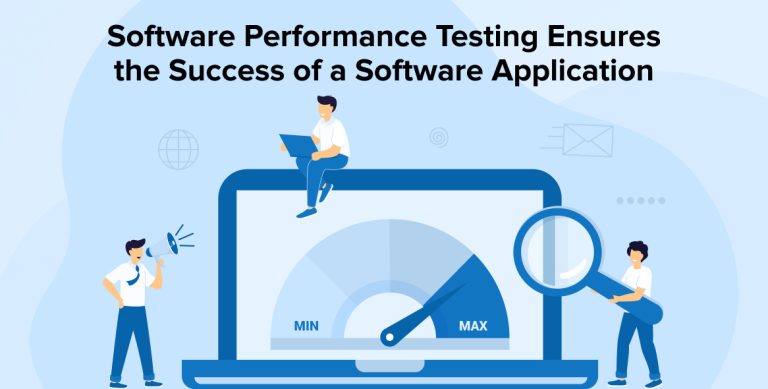Related Blogs

Just a single crash of your software application can prompt your users to move on to your competitors! Do you really want that?
In today’s fast-paced digital world, performance is a make-or-break quality for software. It matters more than the features and look-n-feel of a software application. Speed, Capacity, Scalability, and Stability are key factors that determine the success of a software application. So, to ensure that the software works well and is error-free, Software Performance Testing comes into the picture, which is a means of Quality Assurance (QA).
The software Performance Testing process involves testing various software applications to ensure that they will perform well under expected performance criteria like Users Load, Data Load, Response Time, Hits per second, etc. The objective of such type of performance testing is to eliminate software performance bottlenecks.
This blog post is dedicated to fully understanding the importance of performance testing, the challenges faced during testing, how the system performs and reacts post-performance testing, and what can be achieved by applying the right test methods- all of this will be answered here.
1. What is Performance Testing?
If we go by the name then Performance testing is the process of identifying the performance blockages that interrupt and deteriorate the process of deployment. It is a type of non-functional testing. In other words, if we were to define Performance testing then it is a process of determining how fast, responsive, under stress, or stable a computer, network, software application, or any device is. Performance testing will be conducted in order to identify performance loopholes.
There can be performance breakdown, slower response time, inconsistency, dissatisfaction with the user interface, unexpectedly higher loading time, and several other reasons. They contribute to making the application better and high-performing. For some more clarity, here are some of the examples of performance test cases that might benefit you in understanding the situation when you should opt for performance testing.
- For the first test case, you can see when 10000 visitors use the website at the same time, and also make sure the response time is less than 10 seconds.
- In the second test scenario, check when network connectivity is sluggish, check network configurations of the Application under Load’s response time whether it is within an acceptable range.
- In the third scenario check the maximum number of users it can manage before the application breaks.
- Also, if the application is under stress, examine the application’s and database server’s CPU and memory utilization, and how it works with critical data.
- In the last test scenarios, check the time when concurrent writing and reading of the database take place and execute tests.
You can perform multiple types of performance tests and boost the performance of the developed application. Some tests meet the basic performance testing metrics and meet the standard quality benchmark. One question that arises in the minds of businesses is how would they know when performance testing is needed? The answer is in the next section.
2. Why do Businesses do Performance Tests?
When the speed, response time, load time, and scalability concerns are obstructing your development process then it’s maximum customers. The potential consumers have time to upscale your performance. One of the most significant characteristics of an application is its speed. When the speed gets decreased, you tend to lose maximum customers. The potential consumers will also abandon a slow-running program. So, if you do performance tests on a specified test environment, it will not only boost the performance but also work seamlessly.
Here are some of the performance challenges which demand the performance test
Higher Load Time
The load time of an application is the time it takes for a start-up. This should be maintained to a bare minimum. While certain programs are hard to load in under a minute., Load times should be limited to a few seconds if it is feasible.
Bad Response time
The time it takes for a user to enter data into an application and for the program to respond to that input is known as response time. In general, this should be a pretty short process. If a user is forced to wait too long, they will lose interest.
Non-Scalable
A software product’s scalability is poor when it can’t accommodate the expected number of users or when it doesn’t adapt to new or concurrent users, or if. It is not built with a futuristic approach.
Obstruction
Find the piece of code that is causing the obstruction in the app development process. Identify it and approach it to repair. There is always a different key to resolve specific code bottlenecks.
Barriers are typically alleviated by either improving or adding extra hardware. The following are some of the most prevalent performance bottlenecks:
- Non-functioning of CPU
- Excessive memory Utilization
- Utilization of the many channels
- Limitations of the Operating System
- Use of the hard drive
Performance test ensures that your program operates quickly enough to maintain a user’s attention and interest. Take a look at the following list of typical performance issues and make a note of what you find. The three major focuses of performance testing are speed, scalability, and stability. Businesses can attain all these factors at once, as they choose performance tests. In performance testing, you can apply load testing, stress testing, spike testing, system performance testing, performance monitoring testing, and several other testings.
3. Types of Performance Testing

a. Stress testing: The objective of stress testing is to identify the breaking point of an application and to find out what. happens when the system is pushed beyond the limits, does it break the recoverability of the system?
b. Load testing: The objective is to check loads that your systems are supposed to handle at different times and events mainly to help you in planning your investments and architecture accordingly.
c. Volume testing: The objective of volume testing is to assess your volume needs to help you plan your capacity. Under Volume testing, a large amount of Data is populated in the database and the overall software system’s behavior is monitored.
d. Endurance testing: What about sustained load for long periods of time? The objective of endurance testing is to make sure the application can handle the expected load over a long period of time.
E. Spike Testing: The objective of spike testing is to know about the system reaction when there is a sudden rise in the load generated.
F. Scalability testing: Scalability testing determines if the developed software program is capable of upscaling or whether it can handle an increase in user load. It aids in the planning of capacity expansion for your software system.
4. Performance Testing Steps
Learning how software functions on end-user machines is the first step. Testing software might involve a variety of performance tests. Here are a few of them:
4.1 Load testing
System performance under high loads may be evaluated through load testing. This load may reflect the number of active users or the number of transactions taking place simultaneously. Response times and stability under high loads are tracked by the monitoring system. Workloads like these are quite acceptable in the workplace.
4.2 Stress testing
Stress testing is conducted to evaluate a system’s robustness under scenarios that are not representative of regular operation. More people or business are added to the software’s capacity. The purpose of stress testing is to determine how reliable a piece of software is. It pre s for a software fail, and help us to know how can it get back up and running after a crash?
4.3 Spike testing
As a sort of stress testing, “spike testing” analyzes how well software copes with sudden and sustained increases in workload. Typical workloads are exceeded for relatively brief periods of time.
4.4 Endurance testing
Endurance testing, commonly called “soak testing,” is an analysis of how well a program holds up under typical conditions for a long period of time. In order to identify issues with the system, including memory breaches, endurance testing is performed. When a computer fails to free up unused memory, it leaks. There is a risk that the memory leak might bring the system to a halt.
4.5 Scalability testing
The purpose of scalability testing is to ascertain whether or not a program can efficiently deal with a growing number of users or requests. In order to find out, we may gradually increase the number of users or the amount of data being processed while keeping an eye on how the system responds. In addition, resources like CPUs and memory may be swapped out while the workload remains constant.
4.6 Volume testing
Through volume testing, we can see how well a program scales to handle the massive amounts of data we expect to throw at it in the future. This type of test is sometimes referred to as “flood testing” due to the fact that it involves overwhelming the system with a large quantity of data.
5. What are the Important Performance Parameters Monitored?
Performance is the key for all types of app development. Every business has different app development needs and so there should be a standard barometer of app monitoring. Below mentioned are some of the main parameters that we can use to monitor software performance testing
- Response time: it means the time from when a user enters a request until the first character of the response is received.
- Memory use: the amount of physical memory available to processes on a computer.
- Thread counts: application’s health can be measured by the number of threads that are running and currently active.
- Throughput: rate a computer or network that receives requests per second.
- Bandwidth: shows the bits per second used by a network interface.
- Maximum active sessions: the maximum number of sessions that can be active at once.
- Hits per second: the number of hits on a web server during each second of a load test.
- Error rates: percentage rates of requests with errors.
- Connection pooling: the number of user requests that are met by pooled connections. The more requests met by connections in the pool, the better the performance will be.
6. Performance Testing Tools
Conducting software performance testing has just gotten simpler with the available tools of the market. You don’t have to manually perform the testing process or monitor performance engineering to minimize the continuous load. These tools will help you eliminate performance testing challenges and overcome the resource shortage and technical guidance needs. You must choose tools based on many factors such as Supported protocol types, licensing costs, and device requirements platform dependence.
Nowadays, a wide variety of software performance testing tools are available in the market. Some of the most popular tools are mentioned below:
LoadNinja: LoadNinja is one of the popular ways of performance testing that is changing the way people load tests. This cloud-based load testing solution enables teams to record and playback full load tests in real browsers at scale, without the need for sophisticated dynamic correlation. Test coverage may be increased by teams & reduced load testing time by more than 60%.
HP LoadRunner: It is the most popular software performance testing tool in the market today. This tool is capable of simulating hundreds and thousands of users, setting applications under real-life loads to determine their behavior under expected loads. LoadRunner features a virtual user generator that simulates the actions of live human users. It supports various protocols like web, Windows, SAP, Flex, Silverlight, etc. It’s a commercial tool and costly as well!
Apache JMeter: It is a well-known software performance testing tool in the IT world. Although it’s tech-friendly, it does not support many protocols. It does not possess great GUI features like other commercial tools but it gives correct and trustworthy results if used precisely. JMeter is mainly used for web and web service applications. It can be explored with many other tools like Blazmeter, SOAP UI, New Relic, and YSlow for better extension, analysis, and reporting. One of the best things about JMeter is that it is an open-source, i.e. Free tool!
The selection of tools depends on many factors such as types of the protocol supported, hardware requirements, platform support, license cost, ROI, etc. The right software testing & quality assurance company can help you select the right tool based on requirements and also conduct the software testing effectively and efficiently.
7. Performance Testing Best Practices
One of the most crucial pieces of advice for performance testing is to start testing right away and to keep testing until you’re satisfactory. To put it simply, developers cannot learn what they ought to know from a single test. If you want to evaluate performance effectively, you need to run a battery of smaller tests over and over again.
- If at all feasible, testing should begin within the design phase. Don’t put off performance testing till the last minute of the project.
- Project completion doesn’t mark the end of performance testing. Testing components independently might be helpful.
- Repeated performance testing can guarantee reliable results and help you average out measurements.
- Databases, servers, and services are just few of the many types of infrastructure that are often required to support an application. Put each component through its paces on its own, as well as as a group.
In contrast to testing extensively, there is a set of recommended practices for performance testing that can help ensure success:
- Create a performance testing setting with the help of developers and testers.
- Keep in mind that actual users will be operating the product under test. Think about the users, not simply the servers in the test scenario, while evaluating the findings.
- Ignore the constraints of performance tests. Construct a model by setting up a testing environment that mimics real-world conditions as closely as feasible.
- Failure or success can be determined from baseline measures.
- When testing performance, it’s ideal to do it under conditions that mimic production settings as closely as appropriate.
- Separate the quality assurance testing setting from the performance testing setting.
- Unfortunately, there is no one performance testing instrument that can meet all requirements. Furthermore, the availability of options may be hampered by scarce resources. Find the best performance testing tools by doing some research.
- Always maintain a stable test environment.
- To get useful data, just calculate the averages. Keeping tabs on anomalies might also be instructive. These rigorous tests may help identify potential problems.
- When writing reports to present the results of performance testing, keep your readers in mind. Changes to hardware and software should also be reflected in the reports.
8. Conclusion
Finally, we know every business loves its customers unconditionally and will walk an extra mile for them. But they will love you back only if you offer convenience in a software product that performs better even in extreme conditions.
It is absolutely critical to have a well-performing software application that lets the end user carry out given tasks without undue perceived delay or irritation. The software performance testing process ensures improved customer satisfaction, loyalty, and retention.

Vishal Shah
Vishal Shah has an extensive understanding of multiple application development frameworks and holds an upper hand with newer trends in order to strive and thrive in the dynamic market. He has nurtured his managerial growth in both technical and business aspects and gives his expertise through his blog posts.
Subscribe to our Newsletter
Signup for our newsletter and join 2700+ global business executives and technology experts to receive handpicked industry insights and latest news
Build your Team
Want to Hire Skilled Developers?





Comments
Leave a message...